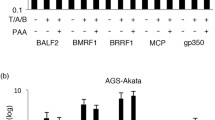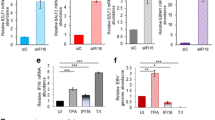Abstract
Experiments will be summarized which address two general questions about the BZLF1 gene. The first is, “what factors regulate expression of the gene?” The second is “which other EB viral genes are activated as the result of ZEBRA expression?”
At least three variables have been identified which affect ZEBRA expression; these are genome rearrangements such as occur in defective virus, cell background, and the response to different inducing agents. In the standard EBV genome ZEBRA is repressed; in certain defective genomes ZEBRA is constitutively expressed. EBV converted BL cells tightly regulate ZEBRA expression, whereas more permissive cells, such as EBV immortalized marmoset cell lines permit spontaneous ZEBRA expression. The inducing agents TPA and butyrate seem to act by releasing transcription of the BZLF1 gene, but their effects vary with genome configuration and cell background.
Cell lines have been created which stably express ZEBRA from BZLF1 maintained on oriP Plasmids. While some of these cell lines express EBV late genes and produce virions, others express only a group of early genes. Among the early genes activated are BZLF1 itself, suggesting an autostimulatory loop. Other activated genes include products recognized by Pearson’s R3 (BMRF1), 5B11 (BHRF1) and K8 (BORF2) monoclonal antibodies. Whether ZEBRA activates expression of these four genes directly or through a cascade remains unknown. Preliminary experiments indicate that ZEBRA is a DNA binding protein. Therefore its mechanism is likely to be that of a transcriptional activator of specific EBV early genes.
Access this chapter
Tax calculation will be finalised at checkout
Purchases are for personal use only
Preview
Unable to display preview. Download preview PDF.
Similar content being viewed by others
References
Baichwal, V.R., and B. Sugden. 1988. Latency Comes of Age for Herpesviruses.Cell 52:787–789.
Weigel, R., and G. Miller. 1983. Major EB virus-specific cytoplasmic transcripts in a cellular clone of the HR-1 Burkitt lymphoma line during latency and after induction of viral replicative cycle by phorbol esters. Virology 125:287–298.
Weigel, R., D. K. Fischer, L. Heston, and G. Miller. 1985. Constitutive expression of Epstein-Barr virus-encoded RNAs and nuclear antigen during latency and after induction of Epstein-Barr virus replication. J. Virol. 53:254–259.
Heston, L., M. Rabson, N. Brown, and G. Miller. 1982. New Epstein-Barr virus variants from cellular subclones of P3J-HR-1 Burkitt lymphoma. Nature (London) 295:160–163.
Rabson, M., L. Heston, and G. Miller. 1983. Identification of a rare Epstein-Barr virus variant that enhances early antigen expression in Raji cells. Proc. Natl. Acad. Sci. USA 80:2762–2766.
Miller, G., M. Rabson, and L. Heston. 1984. Epstein-Barr virus with heterogeneous DNA disrupts latency. J. Virol. 50:174–182.
Jenson, H. B., M. S. Rabson, and G. Miller. 1986. Palindromic structure and polypeptide expression of 36 kilobase pairs of heterogeneous Epstein-Barr virus (P3HR-1) DNA. J. Virol. 58:475–486.
Jenson, H. B., P. J. Farrell, and G. Miller. 1987. Sequences of the Epstein-Barr virus (EBV) large internal repeat form the center of a 16-kilobase-pair palindrome of EBV (P3HR-1) heterogeneous DNA. J. Virol. 61:1495–1506.
Countryman, J., and G. Miller. 1985. Activation of expression of latent Epstein-Barr herpesvirus after gene transfer with a small cloned subfragment of heterogeneous viral DNA. Proc. Natl. Acad. Sci. USA 82:4085–4089.
Countryman, J., H. Jenson, R. Seibl, H. Wolf, and G. Miller. 1987. Polymorphic proteins encoded within BZLF1 of defective and standard Epstein-Barr viruses disrupt latency. J. Virol. 61:3672–3679.
Rooney, C., N. Taylor, J. Countryman, H. Jenson, J. Kolman, and G. Miller. 1988. Genome rearrangements activate the Epstein-Barr virus gene whose product disrupts latency. Proc. Natl. Acad. Sci. USA 85:9801–9805.
Biggin, M., M. Bodescot, M. Perricaudet, and P. Farrell. 1987. Epstein-Barr virus gene expression in P3HR1-superinfected Raji cells. J. Virol. 61:3120–3132.
Grogan, E., H. Jenson, J. Countryman, L. Heston, L. Gradoville, and G. Miller. 1987. Transfection of a rearranged viral DNA fragment, WZhet, stably converts latent Epstein-Barr virus infection to productive infection in lymphoid cells. Proc. Natl. Acad. Sci. USA 84:1332–1336.
Author information
Authors and Affiliations
Editor information
Editors and Affiliations
Rights and permissions
Copyright information
© 1989 The Humana Press Inc.
About this chapter
Cite this chapter
Miller, G. et al. (1989). Role of The Zebra Protein in the Switch Between Epstein-Barr Virus Latency and Replication. In: Ablashi, D.V., Faggioni, A., Krueger, G.R.F., Pagano, J.S., Pearson, G.R. (eds) Epstein-Barr Virus and Human Disease • 1988. Experimental Biology and Medicine, vol 20. Humana Press. https://doi.org/10.1007/978-1-4612-4508-7_2
Download citation
DOI: https://doi.org/10.1007/978-1-4612-4508-7_2
Publisher Name: Humana Press
Print ISBN: 978-1-4612-8852-7
Online ISBN: 978-1-4612-4508-7
eBook Packages: Springer Book Archive




